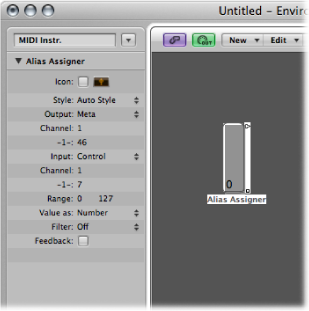Alias Objects
You can create an alias of any Environment object, and it will behave exactly like the original. In the case of faders, the alias has its own value (which can be different from the value of the original object). This is particularly useful if using text faders, as they consume a lot of memory. If you need several text faders of the same name, make several aliases of one original object.
Select the object, then choose New > Alias.
Aliases can be reassigned with meta events. You use a special fader, known as the alias assigner (which works something like the cable switcher), to accomplish this.
Choose New > Fader > Specials > Alias Assigner.
This creates a meta fader, with a -1- definition set to 46.

To use the alias assigner, cable its top output to the alias, and cable subsequent outputs to the various originals that you want to assign to the alias. If you set the alias assigner’s maximum range to match the number of originals and its minimum range to 1, you can then connect the next cable to a new alias, and subsequent cables to originals for the alias. In this way, the alias assigner can be used to assign multiple aliases simultaneously.
One situation in which you might use an alias assigner is when switching a delay line alias between different originals (different delay line objects), each set to different delay times. This method is one of several ways to provide MIDI control over delay time.
If you copy an alias, you create a new alias of the same original. If you select and copy both an alias and its original, you create a copy of the original with its own, separate alias.
Alias Parameters
Aliases share the parameters of their parent (original) objects, but they also have their own, special parameters.
The Channel parameter rechannelizes all events (except fader events), leaving the alias to the selected channel. If the Channel setting is All, existing channelized events are not changed.
For faders, the Channel parameter causes the alias to act as if the original fader’s Input and Output definitions are both set to the specified channel. (An All setting results in no change.)